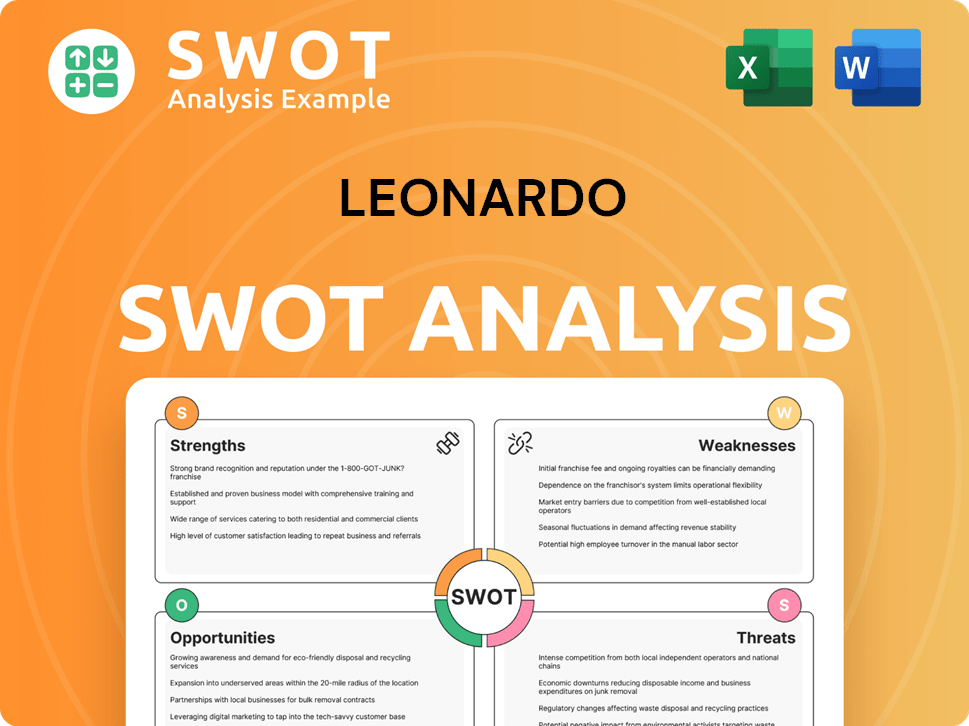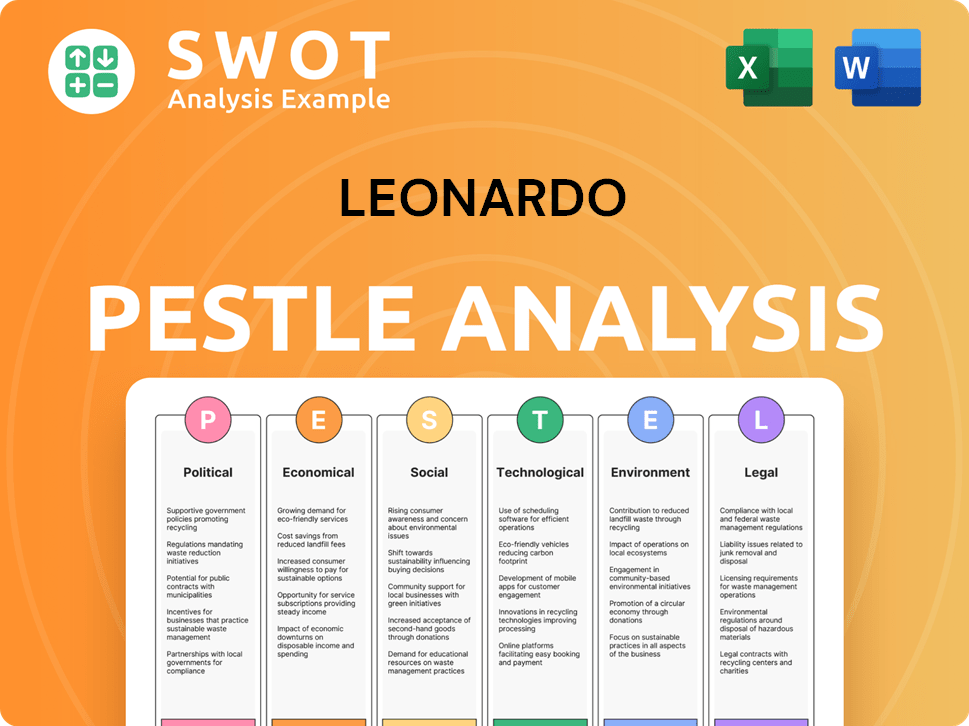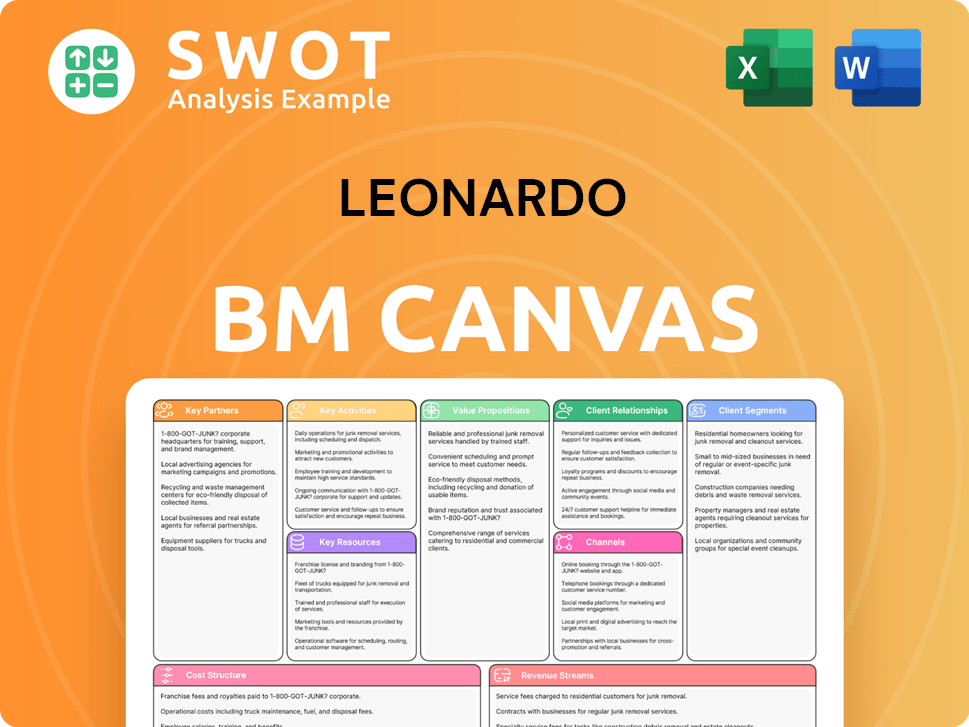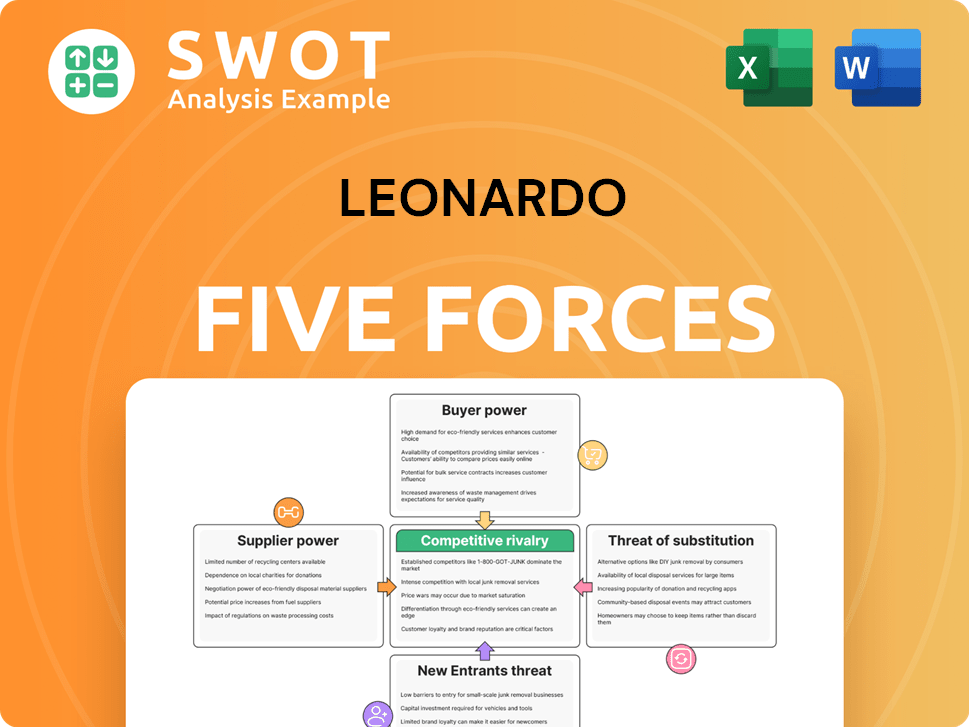Leonardo Bundle
Can Leonardo Company Maintain Its Edge in a Cutthroat Market?
The aerospace and defense sector is a battlefield of innovation and strategic maneuvering, where survival demands constant adaptation. Leonardo S.p.A., a titan in this arena, faces a complex web of Leonardo SWOT Analysis industry rivals and global challenges. Understanding the Leonardo Company competitive landscape is crucial for investors and strategists alike, as it reveals the forces shaping the future of defense and security.

This analysis provides a deep dive into Leonardo S.p.A. market analysis, examining its position within the defense industry competition. We will dissect Leonardo Company's competitors, evaluating their strengths and weaknesses to understand how Leonardo Company navigates the complexities of the global arms market and maintains its competitive advantages. Furthermore, we'll explore the impact of geopolitical events on Leonardo's performance and its future growth prospects.
Where Does Leonardo’ Stand in the Current Market?
Leonardo S.p.a. holds a prominent position within the global aerospace, defense, and security sectors. Its core operations encompass a diverse portfolio of products and services, including helicopters, defense electronics, aircraft, and aerostructures. The company's value proposition lies in its ability to provide advanced technological solutions and integrated systems to government entities, armed forces, and commercial operators worldwide.
The company's financial performance in 2023 reflects a strong market position. Leonardo reported new orders totaling €17.9 billion, a 3.8% increase compared to 2022. Revenues reached €15.3 billion, marking a 3.9% increase over the previous year. These figures underscore Leonardo's resilience and growth in a competitive market.
Leonardo's strategic focus areas include helicopters, defense electronics, aircraft, and aerostructures. The company is a global leader in the helicopter sector, with its AgustaWestland division playing a significant role in both military and civil rotorcraft markets. In defense electronics, Leonardo provides advanced systems for airborne, land, and naval applications. Its aircraft division is involved in military trainers, transport aircraft, and combat aircraft programs. The aerostructures division contributes to major commercial aircraft programs.
Leonardo's market share varies across its business segments. In 2023, the company's backlog reached €39.5 billion, providing approximately 2.6 years of guaranteed production. This strong backlog indicates sustained demand for its products and services. The company's EBITA stood at €1.29 billion, marking a 10.6% increase.
Leonardo has a strong presence in Italy, its home market, and significant operations across Europe, North America, and the Middle East. The company's global footprint allows it to serve a diverse customer base and capitalize on international market opportunities. This geographic diversification is crucial for mitigating risks and ensuring long-term growth.
Leonardo competes with major players in the defense and aerospace industries. Its strong financial performance and diverse product portfolio contribute to its competitive advantage. The company's strategic focus on innovation and technological advancement further strengthens its market position. For more insights, check out the Marketing Strategy of Leonardo.
Leonardo has established strategic partnerships and alliances to enhance its capabilities and market reach. These collaborations are essential for accessing new technologies, expanding into new markets, and sharing risks and resources. Strategic partnerships are a key element of Leonardo's competitive strategy.
Leonardo's competitive advantages include its diversified product portfolio, strong financial performance, and global presence. The company's focus on innovation and technological advancement also contributes to its success.
- A diversified product portfolio across helicopters, defense electronics, aircraft, and aerostructures.
- A strong financial performance, with increasing revenues and a solid backlog.
- A global presence with significant operations in key markets like Europe, North America, and the Middle East.
- Strategic partnerships and alliances that enhance capabilities and market reach.
Leonardo SWOT Analysis
- Complete SWOT Breakdown
- Fully Customizable
- Editable in Excel & Word
- Professional Formatting
- Investor-Ready Format

Who Are the Main Competitors Challenging Leonardo?
The competitive landscape for Leonardo S.p.a. is intense, shaped by global dynamics in the aerospace, defense, and security sectors. Leonardo faces both direct and indirect competition from large, integrated defense contractors and specialized firms. Understanding the strategies and capabilities of these competitors is crucial for assessing Leonardo's market position and future prospects. A detailed market analysis of Leonardo reveals the complexities of its competitive environment.
The company's success depends on its ability to innovate, secure contracts, and maintain strong relationships with governments and international partners. The defense industry is characterized by long-term contracts, technological advancements, and geopolitical influences, all of which impact Leonardo's competitive standing. The company's financial performance and strategic decisions are closely tied to its ability to navigate these challenges.
Leonardo S.p.a. operates in a highly competitive global aerospace, defense, and security market, facing formidable direct and indirect rivals across its diverse business segments. Its primary competitors include other large, integrated defense contractors as well as specialized players in specific product categories. The competitive dynamics are constantly evolving due to mergers, acquisitions, and technological advancements. The following are key competitors in the industry.
Lockheed Martin is a major competitor, particularly in military aircraft, missile defense, and rotary-wing aircraft. The company's extensive portfolio and technological leadership pose a significant challenge to Leonardo. In 2024, Lockheed Martin's net sales were approximately $68.6 billion.
BAE Systems competes with Leonardo in naval systems, combat vehicles, and electronic systems. Their rivalry often plays out in European defense programs and international bids for advanced military technology. BAE Systems reported sales of £25.3 billion in 2024.
Airbus competes with Leonardo in military transport aircraft, space systems, and some helicopter markets. The competition often revolves around large-scale European and international defense projects. Airbus's defense and space revenue in 2024 was approximately €13.7 billion.
Thales is a major competitor in defense electronics, cybersecurity, and aerospace. Both companies vie for contracts in areas like radar systems and digital security solutions. Thales's revenue in 2024 was approximately €18.4 billion.
RTX Corporation competes with Leonardo in advanced defense electronics, missile systems, and aerospace components. Their competition often centers on technological superiority. RTX's total sales in 2024 were around $73.8 billion.
Indirect competition also arises from smaller, specialized firms offering niche technologies or services, as well as emerging players in areas like unmanned systems and advanced cybersecurity. Mergers and alliances continually reshape the competitive dynamics, leading to larger, more integrated rivals with expanded capabilities and market reach. These competitors challenge Leonardo through aggressive pricing strategies, rapid innovation cycles, and strong brand recognition. The global defense market is expected to continue growing, with projections indicating a value of over $2.5 trillion by 2027. This growth will likely intensify competition among the major players.
- The defense industry is highly influenced by geopolitical events, with conflicts and tensions driving demand for advanced military technologies.
- Leonardo's strategic partnerships and alliances play a crucial role in maintaining its competitive edge, especially in international markets.
- Research and development investments are essential for staying ahead in the aerospace and defense sectors, with companies constantly seeking technological advancements.
- Cybersecurity is an increasingly important area of competition, with the rise of digital threats and the need for secure systems.
Leonardo PESTLE Analysis
- Covers All 6 PESTLE Categories
- No Research Needed – Save Hours of Work
- Built by Experts, Trusted by Consultants
- Instant Download, Ready to Use
- 100% Editable, Fully Customizable

What Gives Leonardo a Competitive Edge Over Its Rivals?
The competitive landscape for Leonardo S.p.A. is shaped by its technological strengths, integrated capabilities, and global reach. A thorough Leonardo Company competitive landscape analysis reveals the company's strategic positioning within the aerospace and defense sectors. Key to understanding its market dynamics is examining its competitive advantages and how they stack up against industry rivals.
Leonardo S.p.A. market analysis shows the company's focus on innovation in areas like advanced avionics and cybersecurity. Its ability to offer comprehensive solutions across helicopters, aircraft, and electronics sets it apart. The company’s financial performance and strategic moves are crucial for assessing its competitive edge.
Understanding Leonardo industry rivals and their strategies is essential for a complete competitive assessment. The company’s success depends on its ability to maintain and enhance its competitive advantages in a dynamic global market. This involves continuous investment in R&D and strategic partnerships to stay ahead.
Leonardo's significant investment in R&D, particularly in advanced avionics, radar systems, and cybersecurity, provides a distinct edge. Its expertise in developing sophisticated sensor technology and secure communication systems is crucial for critical defense applications. The continuous evolution of its helicopter platforms, such as the AWFamily, showcases its innovation in rotorcraft design and performance.
Leonardo's integrated capabilities across multiple domains, including helicopters, aircraft, and advanced electronics, set it apart. This allows for synergistic product development and cross-platform integration, providing customers with more holistic systems. For example, Leonardo can equip its own helicopters with its advanced electronic warfare suites, offering a complete, optimized solution.
Decades of delivering reliable and advanced defense solutions have fostered deep trust and loyalty, crucial in a sector characterized by long procurement cycles. These strong relationships, particularly with national governments and armed forces worldwide, contribute to its competitive edge. This brand equity supports its ability to secure high-value contracts and maintain market share.
Leonardo benefits from economies of scale in helicopter manufacturing and large-scale defense electronics production, leading to cost efficiencies. Its extensive global presence and distribution networks enable it to serve a diverse international customer base and access various markets. This global reach mitigates reliance on any single region.
Leonardo's competitive advantages are multifaceted, supported by its technological strengths, integrated capabilities, and global presence. These advantages are crucial for its success in the aerospace and defense markets. Understanding these strengths is essential for a comprehensive Leonardo Company competitors analysis.
- Technological Prowess: Leonardo invests heavily in R&D, particularly in areas like advanced avionics, radar systems, and cybersecurity.
- Integrated Solutions: The ability to offer comprehensive solutions across helicopters, aircraft, and electronics provides a significant advantage.
- Strong Customer Relationships: Decades of delivering reliable defense solutions have fostered deep trust and loyalty.
- Global Presence: Extensive distribution networks and a diverse international customer base mitigate reliance on any single region.
Leonardo Business Model Canvas
- Complete 9-Block Business Model Canvas
- Effortlessly Communicate Your Business Strategy
- Investor-Ready BMC Format
- 100% Editable and Customizable
- Clear and Structured Layout

What Industry Trends Are Reshaping Leonardo’s Competitive Landscape?
The Leonardo Company competitive landscape is shaped by dynamic industry trends, presenting both challenges and opportunities for the company. As a key player in the aerospace, defense, and security sectors, Leonardo faces intense competition and must navigate technological advancements, geopolitical instability, and evolving market demands. Understanding these factors is crucial for assessing Leonardo S.p.A.'s market position and future prospects.
The company's strategic direction is heavily influenced by its ability to adapt to these trends. The defense industry competition is fierce, requiring continuous innovation, strategic partnerships, and a robust financial performance. Leonardo's success hinges on its ability to leverage its strengths while mitigating risks associated with market volatility and technological disruptions. For a deeper dive into the company's origins and evolution, consider reading the Brief History of Leonardo.
The aerospace and defense industry is undergoing rapid technological advancements, including artificial intelligence, autonomous systems, and advanced materials. Geopolitical instability fuels increased defense spending, creating opportunities for companies like Leonardo. Cybersecurity solutions are in high demand, and sustainability is becoming increasingly important.
Leonardo faces intense competition from larger rivals and must manage the cyclical nature of defense spending. Supply chain disruptions and export controls can present operational challenges. Keeping pace with technological advancements requires significant R&D investment. The company's legacy product lines may face declining demand.
Growth opportunities exist in emerging markets, strategic acquisitions, and high-growth areas like space technologies. Expanding cybersecurity services and offering sustainable aerospace solutions can drive growth. Investment in R&D, strategic partnerships, and digital transformation are key to securing future growth. The company can capitalize on increased defense spending.
Leonardo's strategy includes continuous investment in R&D, strategic partnerships, and a focus on digital transformation and sustainability. The company aims to evolve its competitive position and secure future growth. Strategic acquisitions and a focus on emerging markets are also vital for long-term success. The company focuses on innovation in unmanned aerial systems.
In 2024, the global defense market is projected to reach over $2.5 trillion, with cybersecurity spending growing at a rate of approximately 10% annually. Leonardo's R&D investments are crucial for maintaining a competitive edge in the aerospace market analysis. The company's focus on sustainable technologies is aligned with the growing demand for eco-friendly solutions in the aerospace sector.
- Market Growth: The aerospace and defense sector is expected to see steady growth, driven by geopolitical factors and technological advancements.
- Cybersecurity: Demand for cybersecurity solutions in defense is increasing, offering significant growth opportunities.
- Sustainability: Investment in sustainable technologies is becoming increasingly important for long-term competitiveness.
- Strategic Alliances: Strategic partnerships are crucial for expanding technological capabilities and market reach.
Leonardo Porter's Five Forces Analysis
- Covers All 5 Competitive Forces in Detail
- Structured for Consultants, Students, and Founders
- 100% Editable in Microsoft Word & Excel
- Instant Digital Download – Use Immediately
- Compatible with Mac & PC – Fully Unlocked

Related Blogs
- What are Mission Vision & Core Values of Leonardo Company?
- What is Growth Strategy and Future Prospects of Leonardo Company?
- How Does Leonardo Company Work?
- What is Sales and Marketing Strategy of Leonardo Company?
- What is Brief History of Leonardo Company?
- Who Owns Leonardo Company?
- What is Customer Demographics and Target Market of Leonardo Company?
Disclaimer
All information, articles, and product details provided on this website are for general informational and educational purposes only. We do not claim any ownership over, nor do we intend to infringe upon, any trademarks, copyrights, logos, brand names, or other intellectual property mentioned or depicted on this site. Such intellectual property remains the property of its respective owners, and any references here are made solely for identification or informational purposes, without implying any affiliation, endorsement, or partnership.
We make no representations or warranties, express or implied, regarding the accuracy, completeness, or suitability of any content or products presented. Nothing on this website should be construed as legal, tax, investment, financial, medical, or other professional advice. In addition, no part of this site—including articles or product references—constitutes a solicitation, recommendation, endorsement, advertisement, or offer to buy or sell any securities, franchises, or other financial instruments, particularly in jurisdictions where such activity would be unlawful.
All content is of a general nature and may not address the specific circumstances of any individual or entity. It is not a substitute for professional advice or services. Any actions you take based on the information provided here are strictly at your own risk. You accept full responsibility for any decisions or outcomes arising from your use of this website and agree to release us from any liability in connection with your use of, or reliance upon, the content or products found herein.